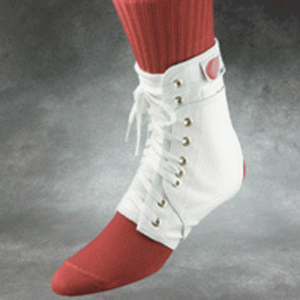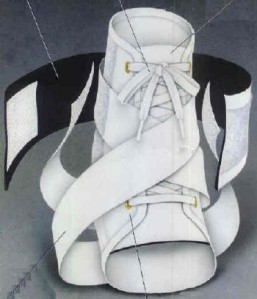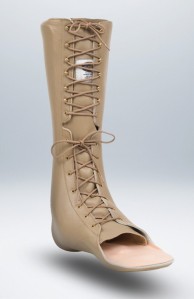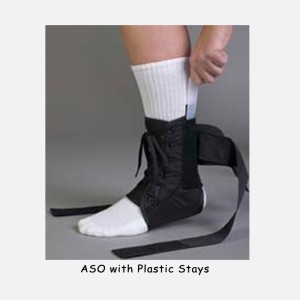The most common type of brace worn is the ankle brace. There are hundreds of varieties of ankle bracing systems in existence…I will probably discuss them all eventually, but today we are going basic.
Very basic.
Right back to the beginning.
When an ankle has been injured, the treatment is to wrap something around it in order to support the joint, give compression to reduce swelling and limit motion. This treatment has been around since the first Egyptian bound some strips of linen around his sandal after he tripped over a rock. (No, really – they have found picture evidence of ancient splinting mixed in with the hieroglyphics in some pharaoh’s tomb).
The truth is, this treatment technology hasn’t really changed much over the years. Modern day athletes have their weak or injured ankles taped by Athletic Trainers. The cloth tape supports the ankle and reinforces it, restricting ankle movement in an attempt to reduce pain and risk of re-injury. This works really well for athletes who have a staff of Athletic Trainers to take care of them. But there are a lot situations when ankle taping is impractical. For example; If the injury is going to need long-term treatment, or if the person does not have access to someone who can tape their ankles. Lace-up ankle braces work very well to approximate the same type of support you would get from a tape job.
The most famous brand of lace-up ankle brace is the Swede-o brace. It looks like this:

If the basic Swede-o brace doesn’t provide enough support for you, I recommend the ASO brace (or something with a similar concept). This type of brace has extra straps that can be wrapped around the ankle to add an additional level of stabilization.

These two types of ankle brace are sturdy, low profile and functional. They fit easily into athletic shoes and can be worn while playing sports or during everyday activities. One draw-back of a lace-up style ankle brace is that it usually takes a bit of time to put them on, what with all the ties and straps.
Both the ASO style and the plain lace-up style ankle braces contain small removable plastic stays on either side of the ankle. When worn with a well-laced shoe the combination of tough fabric and thin pieces of plastic in these braces provide enough stiffness to support most ankles.
Notice I said “most ankles”. I probably should have said “average ankles”. Because as we all know, there are always those people who are not and never will be average. In this case I’m talking about people who either have really whacky ankle alignment or who are in need of serious, big league motion control. But never fear, the lace-up ankle brace category has a big brother…literally. The Arizona brace.

The Arizona brace works on the same principles as the other lace-up braces, just multiply everything by 10. Instead of small, removable plastic stays, the Arizona has a solid plastic core that is custom molded to fit the patient’s ankle. That’s right. I said custom molded. And because you can’t drape molten plastic over someone’s leg (well, you can – but it is very much not advisable) you have to take a cast of their leg and make a model from that cast and then you can make the brace. Yeah. It’s complicated. I’m sure I will write a blog post about the custom brace making process one of these days. For now, all you need to know is that it takes a lot of skilled labor to make a custom brace. And skilled labor = $$$$.
Arizona braces are very expensive. But they are tough and strong and boy do they work. The traditional style Arizona braces have a leather covering over the plastic that allows the brace to be laced up like a logging boot or an ice-skate. The Arizona brace is a bit bulky but most people can still fit it into their regular shoes. Because leather is pretty old-tech and can get gross and smelly, some companies have started making Arizona-style braces out of all synthetic materials. I think this is the way to go. Here’s a picture of what that looks like, in case you are curious.

Now, it’s not all flowers and butterflies with a lace-up style ankle brace. There are some other things that have to be considered. The Arizona brace pretty much renders the ankle immovable. It’s like an ankle fusion without the surgery. Even the wimpier over-the counter lace-up braces limit the up and down movements of the foot and ankle.
Locking up the ankle can be a bad thing. After all, it was designed to move for a reason. For one thing, the ankle adapts to the angles of uneven terrain to make walking easier. Ankle movement also allows the foot to absorb shock with every step. If this doesn’t happen, the jolt of each footfall is transmitted up the leg until it effects the knees, hips and back. This is why everybody should be sure to have just the right amount of support for their own personal needs. Over-bracing is not a good idea. And that’s coming from someone who makes and sells braces for a living.
So if you are a lace-up ankle brace wearer, do a couple of things for yourself:
– Talk to a physical therapist (or someone like that) who can give you some ankle strengthening exercises to do. Maybe you can eventually phase out of your brace wearing, or at least step down to a less-restrictive style.
– Wear your brace when you need it, and don’t wear it when you don’t. This will ensure that your brace lasts longer and that the little stabilizing muscles in your foot and ankle don’t forget how to do their job.
– Do your homework. Make sure you are wearing the best brace for you. At the very least do a google search. You are in charge of your own treatment….just like that Egyptian guy who first wrapped a rag around his ankle. Aaannnd we come full circle.
Walk well!


